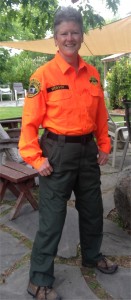One of my latest adventures has been joining the Sonoma County Search and Rescue Team (SAR). Many of our rules, tasks, and attitudes have applicability beyond the SAR environment.
1. Don’t create another victim. Our own personal safety always has to come first; if I get injured, my teammates now have to rescue ME instead of the victim we original set out to help. Put on your own oxygen mask first. When I’m working with a client group, especially if I’m traveling, I need to take care of myself in order to show up well and provide excellent service. I need to make sure I get enough sleep, exercise, eat right, etc.
2. A corollary to #1 is Know your own limits. Self-awareness is a key quality not just for SAR, but for facilitation and training as well. Constant, honest evaluation of my own skills and abilities shows me where I need to improve or train harder. It also makes me better able to evaluate my students, and to devise better learning experiences for them. One place this shows up for me is in scheduling client gigs – I’ve learned from experience how many face-to-face events I can do in a given time frame and still work effectively.
3. Follow the chain of command. The Incident Command System (ICS) implemented in emergency response situations is hierarchical, with very clear roles and responsibilities. When lives are at stake and time is of the essence, people and resources need to be deployed with a high degree of efficiency and effectiveness. While not every organization needs this level of structure, it still needs to be clear to all members WHO is responsible for deciding WHAT and WHEN. ICS also recognizes that there is a limit as to how many units any one person or team can oversee effectively; as the number of people involved grows, so must the organizational structure. Five is considered to be the optimum number of units one person can directly supervise. During my initial contracting and planning phases with a client, I suss out the reporting and decision-making structures of their organization; if they are not clear, that becomes one of the things that we work to rectify in order to meet their goals.
4. Be prepared. In an emergency, you don’t want to waste time searching for supplies or gassing up the car. My 24-hour pack of equipment is already in the trunk of my car, my gas tank is always at least half full, and my uniform is clean and hanging together on one hanger. When the callout comes, I can be dressed and on the road in ten minutes. When preparing for work-related travel, I pack according to a similar system: everything goes in my bag in the same place so that I know I have it. When I show up, I have all my materials, exercises, and agendas ready to go. I’ve thought about everything that could go wrong and created a contingency plan for it.
5. Dress appropriately for your role. Our SAR uniforms communicate safety and authority. While I don’t have a facilitator uniform, I do plan my attire around the culture of my client group.
